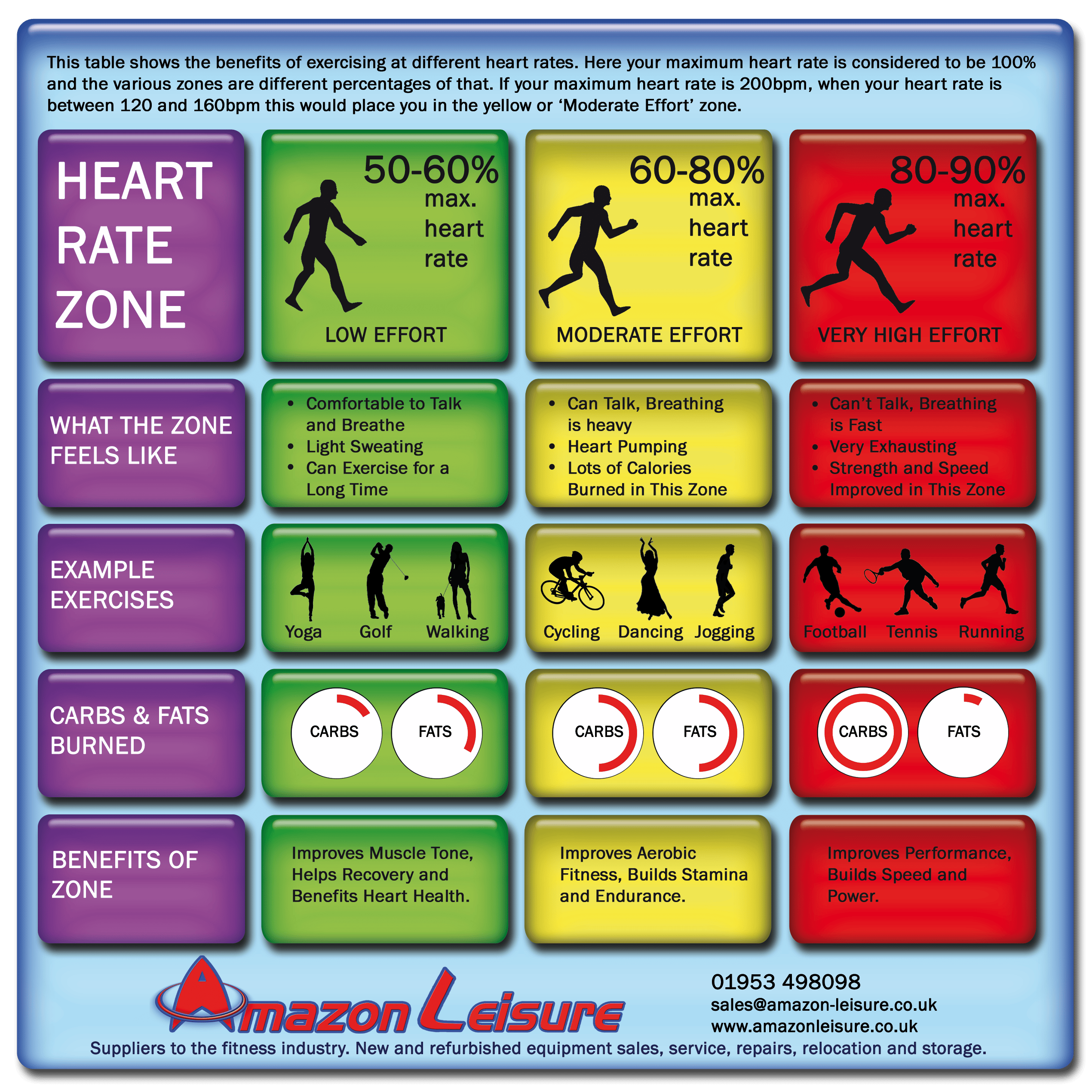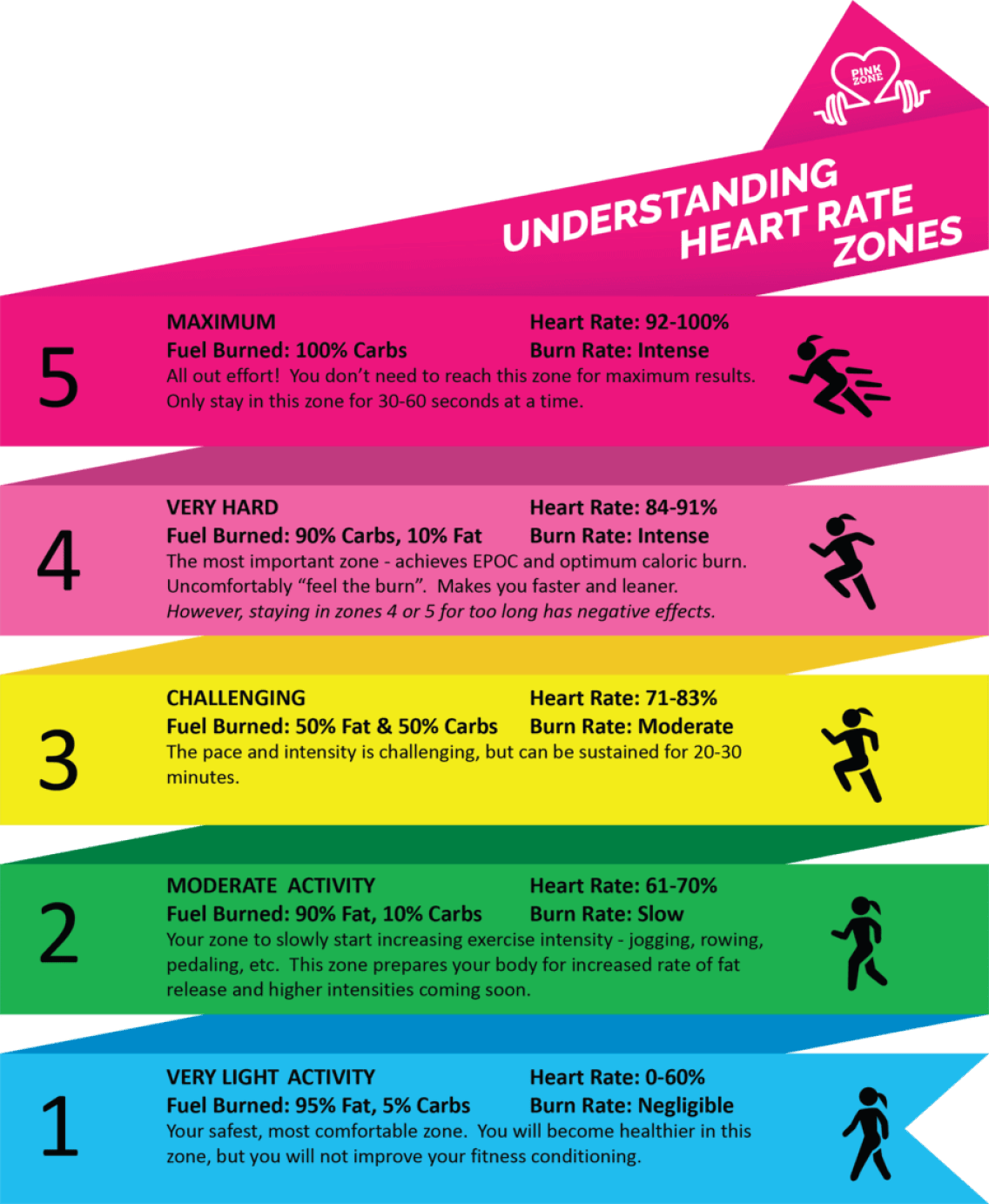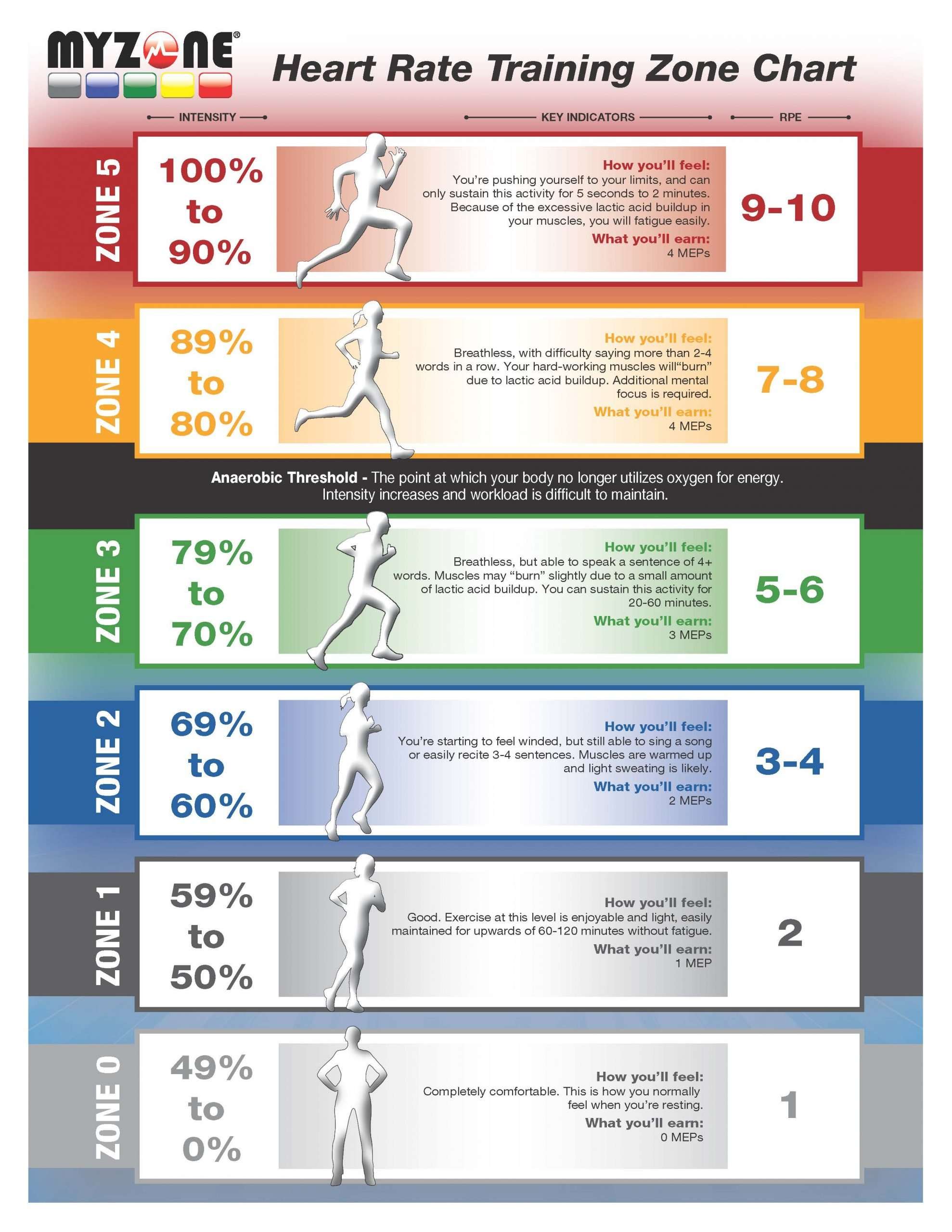How To Use Target Heart Rate Zones In A Training Plan
A typical training plan utilizes multiple training zones. You wont train in each zone for an equal amount of time, though. The time you spend in each zone will vary, usually with more time spent in lower heart rate zones. Heres one example of how a training plan might allocate your time spent in each heart rate zone:
Zone 1: 30%-40% of your time
Zone 2: 40%-50% of your time
Zone 3: 10%-15% of your time
Zone 4: 5%-10% of your time
Zone 5: 5% of your time
A typical training plan will designate precisely how much time you spend in each training zone. As mentioned before, not all training plans use the same exact zones. If you were preparing for a 5K or 10K trail running race and wanted to follow this training plan, for example, youd need to set up your device with heart rate zones that are in that training plan.
Why You Should Use The Heart Rate Zones
Here are a couple of scenarios when heart rate zones really come in handy:
- Many runners tend to run too fast on recovery days. Paying attention to heart rate zones ensure they avoid overtraining.
- Beginners may overestimate their intensity level. Using heart rate zones, they can see how hard theyre really working and make adjustments to reach their fitness goals.
- Advanced exercisers may underestimate their intensity level. Heart rate zones provide data so they can remain in the intended intensity range of their programming and continue to see results.
- Fitness enthusiasts sometimes overdo it. Having heart rate data handy, they can see if their body is overworking during a session that should be easy or moderate. This way, they can scale back to avoid overtaxing their bodies.
Target Heart Rates Chart
What should your heart rate be when working out, and how can you keep track of it? Our simple chart will help keep you in the target training zone, whether you want to lose weight or just maximize your workout. Find out what normal resting and maximum heart rates are for your age and how exercise intensity and other factors affect heart rate.
Read Also: What Are The 4 Stages Of Congestive Heart Failure
How Does This Heart Rate Zone Calculator Work
This health tool estimates the ranges of heart beats per minute for each of the 5 training zones. There are three methods of calculation available, each with separate percentages that take account for the Maximum Heart Rate and the Heart Resting Rate .
These are also the only two variables you need to input in the heart rate zone calculator. In case you dont know your max heart rate, you can compute it with this tool based on your age. There are several formulas available there such as that of Tanaka, Monahan, & Seals or Haskell and Fox.
The HRR is easy to calculate, when at rest and lying down after no period of exertion. You are advised to measure it after 20 minutes since you have lied down. For most people this varies between 60 and 80 beats per minute.
An exercised heart is more efficient as a pump and therefore, in people who frequently exercise, the normal resting heart rate tends to be lower.
The following table presents the available heart zones and after it, each of the calculation methods is explained.
| Zone | |
| 50 – 60 | – |
The first three columns are aimed at describing the type of zone while the fourth column exemplifies the simplest method of determining the training range for each zone, as a percentage from the maximum heart rate.
For example, in the case of a subject with a resting rate of 60 bpm and a maximum heart rate of 185 bpm:
The reserve heart rate is 185 60 = 125.
The percentages corresponding to zone 5 are 90% and 100%.
This means 113 125 bpm.
How Do You Calculate Max Heart Rate

The most widely known formula for calculating ones max heart rate is Haskells equation: 220 age = HRmax
However, this formula wasnt intended to be used for the calculation of fitness programs because maximal heart rate can vary greatly from individual to individual within the same age group. Instead, a more accurate result will be yielded using the Tanaka formula:
208 = HRmax
Example for a 40-year-old:
208 = HRmax208 = HRmax180 = HRmax
This equation is not perfect, but it can still serve as a guide to get you started. If you use wearable technology, you can typically adjust your maximum heart rate using the result that you get using the Tanaka formula for slightly more accurate heart rate zones.
Also Check: What Side Do You Get Pain For Heart Attack
What Is Target Heart Rate
Your target heart rate is a range of numbers that reflect how fast your heart should be beating when you exercise. A higher heart rate is a good thing that leads to greater fitness, says Johns Hopkins cardiologist Michael Blaha, M.D., M.P.H. During exercise, you can monitor heart rate and try to reach this target zone. Doctors also use target heart rate to interpret the results of a cardiac stress test.
What Are Heart Rate Zones
We all have a personal resting heart rate, a minimum heart rate, and a maximum heart rate. And between these values are different HR zones that correspond to training intensity and training benefit.
There are different ways to identify your heart rate zones calculation. One simple way is to define them as percentages of your maximum heart rate, and thats what well focus on in this introduction.
Heart rate zones can be defined as percentages of your maximum heart rate.
Heart rate zones are closely linked to your aerobic and anaerobic thresholds. Understanding this can really help when considering heart rate zones exercise, especially your heart rate zones for running or heart rate zone training for weight loss. But first, lets look at what the different zones are.
Also Check: What Is The Icd 10 Code For Congestive Heart Failure
How To Improve Your Aerobic Capacity
Unless you’re an athlete or training for a specific sport, you should aim for a moderate level of activity during exercise to improve heart health and aerobic capacityyour body’s ability to use oxygen efficiently.
The Centers for Disease Control and Prevention recommends that adults get 150 minutes of moderate-intensity aerobic exercise per week. That can be easily accomplished by getting 30 minutes of activity, five days per week.
You might find it challenging to take your pulse during exercise. Using a device, such as a smartwatch, can help. However, heart rate monitors that use a chest strap are more accurate.
Anaerobic Zone: 80 90%
The third of the four zones is the anaerobic zone at 80% to 90% of your HRmax. This is where your body is burning glycogen and producing the by-product of lactic acid at such a rate that it cant remove it from the muscles fast enough this is known as your lactate threshold. By training in this zone, which youll really feel, you can improve your lactate efficiency to help remove it at higher quantities in the future. Activities that will put you in this zone include sprinting and high-power cycling.
You May Like: Does Congestive Heart Failure Go Away
How Do I Get My Heart Rate In The Target Zone
When you work out, are you doing too much or not enough? Theres a simple way to know: Your target heart rate helps you hit the bullseye so you can get max benefit from every step, swing and squat. Even if youre not a gym rat or elite athlete, knowing your heart rate can help you track your health and fitness level.
What Are The Five Heart Rate Zones
Your heart rate is the best indicator of how hard your body is working during a training session. Whether you run, swim, cycle, lift weights, or do bodyweight HIIT workouts, training with heart rate zones can help you hit specific intensity targets.
In this article, learn the benefits of using heart rate training zones and how utilizing data can help you reach your fitness goals faster.
Also Check: Why Does My Heart Rate Increase After Drinking Alcohol
What Is Heart Rate Training
To nobodys surprise, heart rate training relies on your heart, measured in beats per minute , as it circulates blood through your system.
Its basically your bodys response to the effort youre exerting, so the harder you run, the higher your heart rate.
When you train by heart rate, you create certain training zones then exercise at a specific effort for a set period of time. These ranges are expressed as a percentage of the maximum heart rate.this is the maximum number of times your heart beats in one minute.
Each zone corresponds to specific physiological processes occurring inside of your body.
These zones help you to work on specific adaptations, from aiding in recovery to improving endurance with base training.
Thats why a well-planned running plan should involve a mix of hard efforts and easy efforts to make you as fit as possible.
For example, for a 1-hour run, you might shoot to keep your heart rate between 75 and 85 percent of your maximum heart rate. The rest is just details.
The ideal heart rate ranges are a personal thing. These depend on many factors, such as your age, fitness level, and training goals .
How To Calculate Your Heart Rate Zones And What They Mean

Even if you dont have a heart rate monitor, its useful to understand the benefits you get from working at different effort levels
Heres something you already knew: you can put different levels of effort into exercise. And heres something you instinctively know: those different levels of effort have different effects on your fitness. Working out and tracking your heart rate zones is the best and, with heart rate monitors appearing on more and more fitness trackers, the easiest way to make sure youre putting the right level of effort into a session to achieve the result youre looking for.
That could mean working hard enough to make high-intensity interval training effective, or it could help new runners follow directions to complete easy, steady, tempo and stride sessions in a training plan.
If people understood how to use the information that is provided, there is no doubt more people would be using them with all of their training, says personal trainer and Polar ambassador Harry Thomas. Every single one of my clients uses heart rate monitors in our sessions and once theyve experienced the benefits, they wouldnt go back.
Thats why heart rate monitoring is one of the most useful features available on fitness trackers because it can provide an accurate picture of your overall fitness and how challenging individual training sessions actually are.
Also Check: What Cause Heart Attacks In Young Adults
Ask Stew: How Heart Rate Zones Affect The Way You Train
Ideas about aerobic endurance training split the fitness world in two groups, those who prefer lifting and higher-intensity training and those who do more cardio training . Heart-rate zones can help you determine whether you are training in the aerobic or anaerobic zone, depending on your current fitness level and age.
There is nothing wrong with training at a higher intensity, but the body can also use some downshifting in the slower-paced training of zone 1 and 2. The lower zones can help with stress reduction, so do not blow off the easy walk for mental health and stress mitigation.
Here is a great email that hits on many issues faced by people who train hard all the time.
Hey Stew. I recently discovered Zone 2 training after being a HIIT guy for years. I am not the best long-distance runner and have issues with knees and shins. Can I still do this zone training without running? I am still trying to get better at timed runs, so I will need to run soon. Any assistance? Thanks Cal
Cal, it is smart to diversify your training and not redline with high intensity interval training all the time. If you want to increase your aerobic endurance, build an aerobic base with zone 2-level training.
If you are not familiar with heart-zone training, here are the heart-rate zones for training. Depending on your age and resting heart rate, you can target different energy systems by monitoring your heart and breathing rates.
How To Track Your Heart Rate During Exercise
It goes without saying: You’re likely not going to sit with your fingers on your pulse and a calculator in hand to calculate your heart rate at any given point during a workout. That’s where heart-rate trackers come in handy. Some of them are even so advanced they can tell youbased on your heart rate variability, resting heart rate, and other factorsexactly how hard your body is working over a training period, help guide you into your personal workout heart rate zones, and judge your fitness performance over time.
Consider investing in the WHOOP , an endurance activity/running watch like a Garmin, a FitBit for more general activity and step tracking, or an Apple Watch for something that fits seamlessly into your everyday life.
You May Like: What Are The First Signs Of A Heart Attack
Why Is My Resting Heart Rate Decreasing
As mentioned above, a low resting heart rate is often a sign that youre in peak physical fitness. However, in some cases, a low RHR could cause you to feel dizzy or exhausted. If youre experiencing these symptoms and are wondering why is my resting heart rate going down, then you should speak to a doctor. Its also good to remember that medications like beta-blockers are designed to slow your pulse down as they block adrenaline. So always be mindful of what prescription drugs you are taking and how they could be affecting your RHR.
What Should Your Heart Rate During Exercise Be
Heart rate increases during physical activity, meaning the heart performs more beats per minute to meet the demand of delivering oxygenated blood around the body and to the working muscles. According to the American Heart Association , there are many long-term health benefits associated with regular exercise that elevates the heart rate, including improved circulation, lower blood pressure, lower levels of ‘bad’ cholesterol, and a reduced risk of heart disease and stroke.
The heart is a muscle, and conditioning it to work more effectively with exercise also lowers your resting heart rate , which is a marker for good health. A normal RHR for adult men and women ranges between 60-100 beats per minute and a 2013 study published in Heart Journal found that an elevated RHR is not only an indicator of poor physical fitness, but a risk factor for mortality.
Using heart rate as a training metric is an effective method to improve health and fitness and it’s not a new concept. According to the American Council on Exercise , it’s an accurate way to gauge how hard the body is working during exercise in order to get the associated cardiovascular benefits, without putting a strain on your system.
You can achieve different levels of intensity by incorporating an exercise machine into your workings, and you can monitor your heart rate with most of the best fitness trackers.
You May Like: Prognosis For Congestive Heart Failure
Understanding Your Target Heart Rate
Nearly all exercise is good. But to be sure youre getting the most fromyour workout yet staying at a level thats safe for you, you can monitorhow hard your heart is working.
Aiming for whats called a target heart rate can help you do this, says Johns Hopkins cardiologist Seth Martin, M.D., M.P.H. Think of it as the sweet spot between not exercising hard enough and overexerting.
Get In The Zone: How To Burn Fat Fast With Target Heart Rate Training
If youve ever been curious about heart rate zones, nows the time to give target heart rate training a shot. Fitbit trackers with PurePulse automatically set your heart rate zones for you, making getting started a snap. Heres how to use this function to help improve results, prevent overtraining, and even avoid injury.
Also Check: How Do You Feel After A Heart Attack
The Anatomy Of A Running Workout
Each running workout in the Running Program consists of these elements: workout type, duration, phases and training time in specific heart rate zones.
Each of the five workout types has a different target and each workout includes a warm-up and a cool-down.
An interval training session might include, for example, 8 phases and last for 40 minutes.
First, youll warm up for 14 minutes in heart rate zones 13. Then, youll do six repeats, alternating between hard and moderate repeats. The eighth phase is the 5-minute cool-down.
You See The Big Picture

Training for a running event is bigger than any individual training session. The Polar M430 tracks all the different sports you do. Say, you go cycling instead of running. No worries! Tracked.
In addition to being your track-side coach, Polar M430 is your long-term training partner and advisor that tracks all your training so that the Running Program can suggest adjustments to your running plan on the go.
And if youre curious about what finish time you could aim for, take a look at the Running Index report on Polar Flow, visible at the bottom right. It estimates your finish times for different events, such as a half marathon.
This is what we mean when we say the Running Program is adaptive and personal.
Also Check: How To Take Your Own Heart Rate
